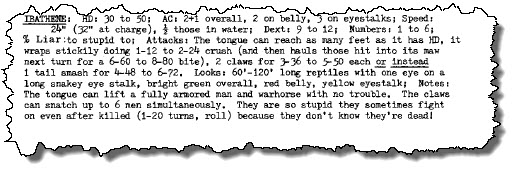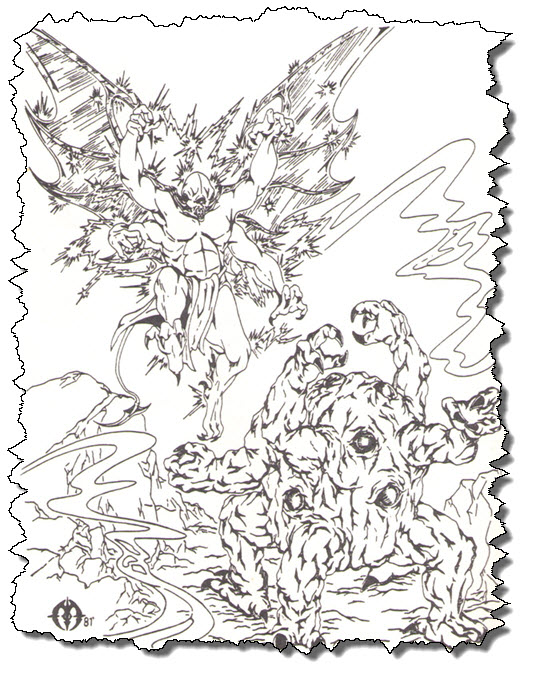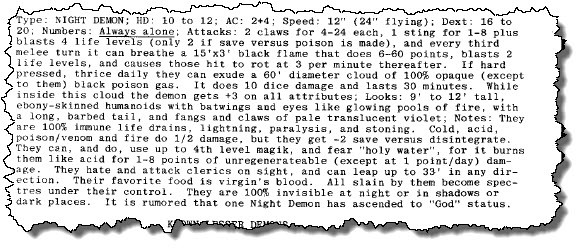Arduin Grimoire, Part XV
Arduin Grimoire, Part XV (And Final)
Air Sharks and Doomguards, and Hell Stars, Oh My!
And Demon Lore
And The 21 Planes Of Hell!
And We’re Done!
As we finally drift towards the end of the first book, we go out on a high note, probably F sharp. (Is that a high note? I don’t actually know anything about music, so my pun might fall flat. Get it? Flat? Sigh. Enjoy the veal, and don’t forget to tip your waiter.)
But seriously, folks: Monsters. Three pages of them, for 16 in all. Yes, you could fit 16 monsters onto three (half size) pages back then, because we didn’t need a lot of ‘background’ or ‘details’, we had imagination! Also, very small type.
Air Shark
Screw your land sharks! We’ve got air sharks!
Key points on the general layout:
- Hit Dice come in ranges, which is even better than pints, unless you’re a hobbit. I covered this an article or two back, so, go dredge it up for yourself. Point is, it was a real innovation for the time.
- I discussed %liar (vs. %lair) a while back, too.
- I have no idea why AC is ‘5+2’ instead of ‘3’. And if you don’t know how 5+2=3 for Armor Class, you are not Old School.
- I’m not sure if you were supposed to roll for speed, or scale it to the hit dice.
- It was cool they had a Dex score, but I’m not sure how it was applied. I don’t remember actually ever using it in play.
- Damage also scales. 8-80???? Remember, boils and ghouls, at the time, a huge ancient red dragon had 88 hit points, and Lolth, a verifiable goddess, had 66.
- Oh, I do so wish someone in one of my games had shot a flaming arrow at one.
Here’s others of interest:
- Blue Bellower: Giant blue rhinoceros beetle that emits a nauseating gas when wounded, and has a 50% chance of having lightning bounce off its shell, and produces a bellow that has a 35% chance to deafen targets for 1-6 turns.
- Doomguard: Perhaps my absolute favorite critter from this book, because I keep using them in games, in various guises. They’re animated suits of plate armor that can teleport and must “literally be dismembered” to stop. No word on if they inform you that “It’s just a flesh wound!” when injured.
- Grey Horror: Scorpion/Spider hybrid whose poison paralyzes most creatures but dissolves hobbits at 3-18 points/turn. Why hobbits? Why not hobbits?
- Hell Maiden: Skull-headed Valkyries who ride hell horses (which are, for the record, also described). Despite having skulls for heads and riding undead horses, they’re not undead. They do have a ‘%liar’ of 90%, though, so perhaps they’re lying about not being undead?
-
Ibathene: Nuff said. OK, it’s not up to Galactic Dragon status, but still… and if you look back at Part XIV, you’ll note there’s a 1-in-20 chance of a random trap dumping you on one of these. Erm.. or not. Huh. Another difference between editions. Where it says “purple worm” there, later editions say “ibathene”. Also, on the treasure tables, they replaced “pizza oven” with “machine gun”.
- Knoblin: Kobold/Goblin/Bat hybrids. Because the world needs as many low-HD humanoids as it can get. Like the Ibathene, and like many other monsters of this era, it had different AC for different body part — normally 6, wings were 8. This is not, in itself, remotely problematic. What is problematic (and lest anyone be confused, this applies to D&D and AD&D itself, and is not a jibe at Dave, for he’s guilty here of nothing more than cargo cult game design, a sin most everyone in this era committed), is that there were never any official or integrated rules for targeting body parts. Do you just say “I’m aiming for the wings?” Do you randomly determine which body part is being hit, and then use that body part’s AC? Is there a penalty? Does it make sense for there to be a penalty since the whole point is to aim for the lower-AC body part? If you miss, do you hit the body? There were as many answers as there were gaming groups, and the answer depended on the DM’s ideas about combat, his/her interest in making house rules, and how much Chinese food had been made available.
- Kobbits: Kobold/Hobbit crossbreeds. Rule 34 just exploded. Next!
- Phraint: Phraints are awesome. They’re mantis people. There’s one on the cover of the later edition; you can see the scan on the main Arduin page. They’re covered in detail in Book 3, the Runes of Doom, which, if I follow the same rate of posting, we’ll be getting to in about 15-20 weeks.
- Skyray: One-eyed, flying, manta-rays which explode into a cloud of spores when they die, “seeding” all in the cloud as their “host”, with, and I quote “predictable result” in 1-3 months.
- Thermite: Glowing red-yellow giant warrior termites, that do 1-8 points of fire damage on a touch. Well, my subconscious stole that for Earth Delta. I should have known I wasn’t clever enough to come up with that on my own.
- Thunderbunnies: While it sounds like the name of a strip club, these are actually insane, “foam mouthed”, jack rabbits that travel in great herds “like land piranhas”.
- Golems: Can you ever have enough golems? Of course not, duh! We get gold, silver, orichalcum, adamantine, mithral, shadow, and light. A while back, inspired by an entry in, I think, Welcome To Skull Tower, I statted out a green slime golem.
Demon Lore
Stuff Your Heavy Metal Albums Never Taught You
We now have a page of rules about demons, numbered with roman numerals, because why not, and with many underlines to show emphasis.
- You need to be the same level as a demon to conjure it, and your chance of controlling it is only 10%, which increases very slowly as your level exceeds its. Also, for greater demons, this number is halved. Sucks to be you.
- Demons hate everything, including their own kind (75% of attacking).
- Demons just dissipate back to hell when killed, and they also regenerate like trolls, presumably by registering new Twitter accounts. Lesser demons, however, can be killed by phasers and nuclear bombs, and the mere fact that sentence exists makes me very, very, happy.
- Only dragons and other demons can damage demons, but medusas (only, not gorgons or basilisks) can stone them. Elementals and efreet do half damage; golems, one-quarter damage. I want to be in a game where the issue of golem-on-demon combat comes up.
- 50th level Patriarchs have a 5% chance to turn away greater demons (+1% per level).
- The main purpose of demons is to flip out and kill people.
- Demons are mammals.
- Demon attacks and saving throws are rolled as if they had double their hit dice, e.g., a 6 hit die demon attacks and saves as a 12 hit die monster. Combine this with their regeneration and other powers, and it amazes me any character in Dave’s games ever made it to fifth level, never mind fiftieth!
Here’s a Rock Demon vs. a Storm Demon. You’re welcome.
The Planes Of Hell
Not To Be Confused With The Plains Of Hell, Which Are Called “Nebraska”
Seriously, Have You Ever Driven Through Nebraska?
Now we have a listing of Planes of Hell, which feature the usual medieval imagery like tidally-locked worlds with superheated argon atmospheres, or dying suns and pools of liquid mercury, or radioactive vacuum worlds dotted with h-bomb craters, or…
Wait, what?
The “21 planes of Hell” in the Arduin-verse are, it seems, hellish sci-fi worlds, which is really cool (even if most of them just kill you instantly) but totally way out in… it’s not even left field, it’s out of the ballpark, down the street, and eating pizza at a hole in the wall pizzeria. Other than the fact the inhabitants are listed as various sorts of demons (which might as well be mutants or aliens, really), there’s virtually no connection between any conception of “hell” I’ve ever heard of. I mean, did Dante ever cover a planet “burned with energy weapons in an interstellar war”?
The 20th plane of hell has an ocher sky, four coppery moons, and billowy fungus forests. Also, star demons.
The 21st level of hell, home to the greater demons (which are noted as mutations, BTW) is filled with bombed-out cities and “dark red mutated seas”, also, kaleidoscope skies and an evilly blue glowing moon.
I would love to hear the backstory behind how these vividly strange worlds become the “hell” of Arduin…
Some Demons
We now get an assortment of “lesser” demons. I’m just going to include one typical example. I shudder to imagine what “greater” demon stats might have looked like; I’m not 100% sure, but I don’t think they were ever included in the other books.
I also like how it can leap 33′ in a round… again, a number perfectly suited to no mapping system ever used.
And In Conclusion…
Dave ends by saying “The overland and dungeon maps on the next two pages are provided for your interest and enjoyment”, which is nice… but there’s only a dungeon map. As I commented regarding a similar omission in the Princecon III handbook, it’s hard to find a more perfectly zen summary of the essence of old-school supplements. How many days of game time does it take to cross a missing map, grasshopper?
Next Time…
We delve into “Welcome to Skull Tower”. A lot of people have covered/reviewed/dissected the Arduin Grimoire, but far less attention has been paid to the later volumes of the trilogy. This should be fun…





Why is 5+2 not 3?
Because of the Armor v. Weapons adjustment table. See Greyhawk.
That’s completely sensible, and I’m embarrassed for not realizing it.
That’s completely sensible, and I’m embarrassed for not realizing it.
I’ll point out that Night Demons don’t DRAIN levels they BLAST levels. IIRC the difference is that drained levels can be restored and blasted levels can only be regained though gaining experience again.
And absolutely right you are! Thank you for calling my attention to it. I kind of blorped over the level blast/drain rules when they came up (http://mrlizard.com/reviews-and-walkthroughs/arduin-grimoire-part-x/), and now, I go back to re-read them, and it’s plain as day. Drained life levels recover one per month of absolute rest, while “blasted” life levels require XP or a wish. (p. 38)
There is so much stuff hidden in the maze of twisty little paragraphs in these books, I keep finding new things… there’s a very real kind of magic (or magik) here.
Pingback:Welcome To Skull Tower, Part I | Lizard's Gaming and Geekery Site
Pingback:Welcome To Skull Tower, Part III | Lizard's Gaming and Geekery Site
The best inclusion of DEX scores in this edition of AG may be due to the release of the Holmes basic set (a “precursor” to AD&D that wasn’t) in which initiative was determined by DEX order. The 1st printing of the B2 module includes DEX stats for common monsters as well. This is the only edition of D&D to use that system.
Holmes is essentially using the Perrin Conventions, a set of supplemental D&D rules popular on the West Coast for filling out some gaps in OD&D (of which there were many). There wasn’t a formal initiative system in OD&D.